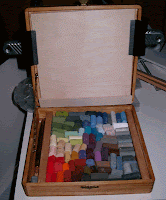A student had stored these pastels in a nylon carrier which holds six plastic boxes. Each box contained a selection of hard and soft pastels in roughly analogous colors. Because there was no rice or foam or compression holding the pastels in place, they danced jigs against each other. The resultant grey slurry coated the sticks, making it impossible to tell what color each pastel was.
We are cleaning them and putting a bed of rice in the bottom of each tray, but the process takes hours. Better to avoid the problem.
White rice (uncooked, please!) is a tried and true method of keeping pastels clean. It is cheap and renewable. (Be careful disposing of it, since it might tempt small animals.) Nevertheless, little rice-filled boxes are a pain in the neck to handle en plein air.
My favorite pastel box has hard panels which press in place with Velcro seals. These hold my pastels securely between two sheets of foam. My local art supply store has discontinued it because it isn’t well-made (I’ll vouch for that) but rather than show you some commercial alternatives, I’d suggest that you look at this delightful rendition made out of a cigar box. For my purposes, it’s too small, but I do like the price.
 Cori Nicholls’ cigar box pastel pochade. Devilishly clever, follow her link, below!
Cori Nicholls’ cigar box pastel pochade. Devilishly clever, follow her link, below!
